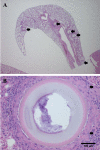Adiaspiromycosis of an Apodemus agrarius captured wild rodent in Korea
- PMID: 22474477
- PMCID: PMC3315196
- DOI: 10.5625/lar.2012.28.1.67
Adiaspiromycosis of an Apodemus agrarius captured wild rodent in Korea
Abstract
Adiaspiromycosis is caused by pulmonary infection with Emmonsia. Inhalated spores of Emmonsia cause asymptomatic infection to necrogranulomatous pneumonia, depending on the burden of adiaspore and host immunity. For disease monitoring of wild rodents captured on Jeju Island in Korea, we examined the lung tissue of wild rodents histopathologically. Spores composed of thick three-layered walls were found following histopathological examination and were diagnosed as adiaspiromycosis. Adiaspiromycosis has been found in mammals in many parts of the world. To our knowledge, this is the first report of adiaspiromycosis of an Apodemus agrarius captured in Korea.
Keywords: Adiaspiromycosis; Emmonisia crescens; wild rodent.
Figures

Similar articles
-
Adiaspiromycoses in Wild Rodents from the Pyrenees, Northeastern Spain.J Wildl Dis. 2024 Apr 1;60(2):526-530. doi: 10.7589/JWD-D-23-00100. J Wildl Dis. 2024. PMID: 38264856
-
Adiaspore development and morphological characteristics in a mouse adiaspiromycosis model.Vet Res. 2020 Sep 15;51(1):119. doi: 10.1186/s13567-020-00844-3. Vet Res. 2020. PMID: 32933583 Free PMC article.
-
Detection of sarcocystic infection in a wild rodent (Apodemus agrarius chejuensis) captured on Jeju island.Lab Anim Res. 2011 Dec;27(4):357-9. doi: 10.5625/lar.2011.27.4.357. Epub 2011 Dec 19. Lab Anim Res. 2011. PMID: 22232647 Free PMC article.
-
Adiaspiromycosis causing respiratory failure and a review of human infections due to Emmonsia and Chrysosporium spp.J Clin Microbiol. 2012 Apr;50(4):1346-54. doi: 10.1128/JCM.00226-11. Epub 2012 Jan 18. J Clin Microbiol. 2012. PMID: 22259200 Free PMC article. Review.
-
[Adiaspiromycosis--a little known lung disease].Z Erkr Atmungsorgane. 1982;159(2):131-45. Z Erkr Atmungsorgane. 1982. PMID: 6762779 Review. German.
Cited by
-
Molecular Diagnosis of Emmonsia-Like Fungi Occurring in Wild Animals.Mycopathologia. 2020 Feb;185(1):51-65. doi: 10.1007/s11046-019-00353-8. Epub 2019 Jun 24. Mycopathologia. 2020. PMID: 31325117
References
-
- Chantrey JC, Borman AM, Johnson EM, Kipar A. Emmonsia crescens infection in a British water vole (Arvicola terrestris) Med Mycol. 2006;44(4):375–378. - PubMed
-
- Sigler L. Ajellomyces crescens sp. nov., taxonomy of Emmonsia spp., and relatedness with Blastomyces dermatitidis (teleomorph Ajellomyces dermatitidis) J Med Vet Mycol. 1996;34(5):303–314. - PubMed
-
- Emmons CW, Jellison WL. Emmonsia crescens sp. n. and adiaspiromycosis (haplomycosis) in mammals. Ann N Y Acad Sci. 1960;89:91–101. - PubMed
-
- Borman AM, Simpson VR, Palmer MD, Linton CJ, Johnson EM. Adiaspiromycosis due to Emmonsia crescens is widespread in native British mammals. Mycopathologia. 2009;168(4):153–163. - PubMed

